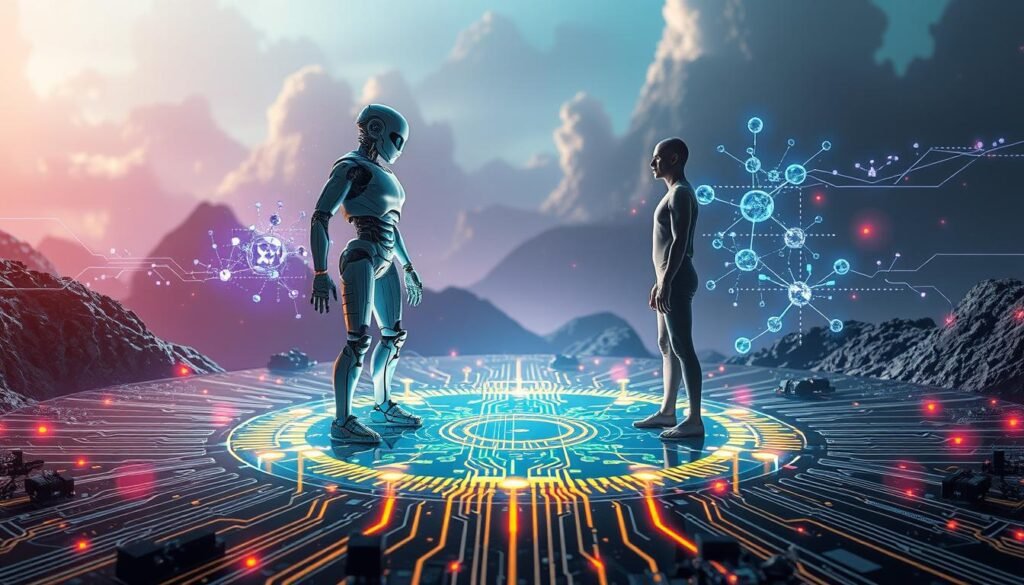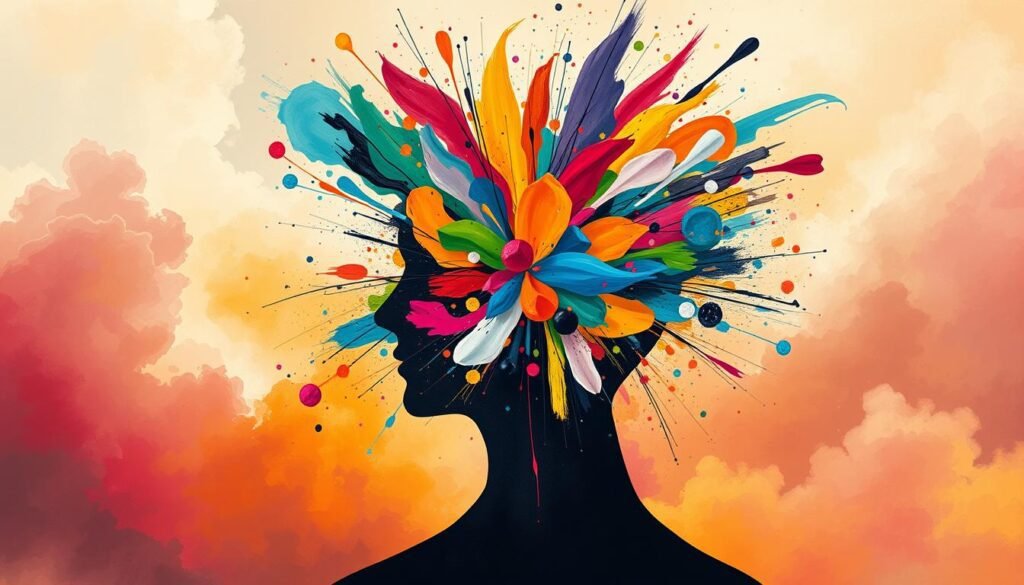Many people wonder if artificial intelligence (AI) can replace human smarts. As AI gets better, we face big questions about what it can do and what it can’t. We’re talking a lot about whether AI can outsmart us and what that means for our future.

This article dives into the world of AI and its chances of beating human smarts. We’ll look at where AI stands now and what it can’t do. We’ll also explore what makes us special that AI can’t copy. This will help us understand the good and bad sides of AI outsmarting us.
Key Takeaways
- AI technologies are rapidly advancing, raising questions about their capabilities and limitations.
- The debate around can AI replace human intelligence is becoming increasingly relevant.
- Artificial intelligence vs human intelligence is a complex topic that requires careful examination.
- Understanding the limitations of AI is crucial to determining its potential to surpass human intelligence.
- The unique aspects of human intelligence are essential to consider when exploring the possibilities of AI surpassing human intellect.
- The future of human-AI collaboration will depend on our ability to balance the benefits and challenges of AI technology.
Understanding the Fundamentals of AI and Human Intelligence
To understand AI vs human intelligence, we need to know the basics. Artificial intelligence is about making computers do things that humans do, like learn and solve problems. Machine learning is key to AI, letting systems get better with time.
Human intelligence is complex, with skills like reasoning and memory. AI works differently, using computers to process information. This makes AI strong in some ways but weak in others.
Human skills like intuition and creativity are hard for AI to copy. AI can handle lots of data but can’t match human thought’s depth. Knowing these differences helps us see how AI and humans can work together better.
The Current State of AI Technology
AI has made big strides in many areas, like machine learning and understanding human language. Tools like ChatGPT can now talk back to us. This tech is used in real life, like in healthcare, where AI checks medical images for health issues.
AI is already changing our world in many ways. Here are a few examples:
- Autonomous vehicles use AI to drive and make choices on the fly.
- Virtual assistants like Siri and Alexa understand our voice commands thanks to AI.
- Image recognition systems can spot objects and people in photos very accurately.
Artificial intelligence is now a real force, changing how we work and live. As AI keeps getting better, we’ll see even more cool uses of it in the future.
It’s important to know where AI stands today and its role in growth and innovation. By using the latest AI tech, we can open up new chances and make a better future for all.
Beats Studio Cancelling EarbudsCan AI Replace Human Intelligence? A Deep Analysis
Exploring artificial intelligence, we see a big difference between the human brain and computers. The human brain can learn and adapt in ways computers can’t. It has complex connections that let us understand emotions and context.
AI and human learning are very different. AI uses algorithms to get better, but humans learn through experience and creativity. AI still can’t match the creativity and innovation of humans.
Some key differences between human and artificial intelligence include:
- Emotional intelligence: Humans understand and respond to emotions in a way AI can’t.
- Creative problem-solving: Humans find new solutions to complex problems, but AI is limited by its programming.
- Contextual understanding: Humans get subtle cues and nuances, while AI relies on explicit data and rules.
Looking at AI replacing human intelligence, we see big challenges. AI is great at processing data, but it lacks human creativity, empathy, and emotional understanding.
| Characteristics | Human Intelligence | Artificial Intelligence |
|---|---|---|
| Learning | Contextual, emotional, and experiential | Algorithmic, data-driven, and programmed |
| Creativity | Novel, intuitive, and innovative | Limited, rule-based, and predictable |
| Emotional Intelligence | Empathetic, understanding, and responsive | Lacking, with limited emotional awareness |
Breaking Down AI’s Strengths and Limitations
Artificial intelligence has made huge strides in recent years. Its artificial intelligence strengths are used in many fields. Yet, it’s key to know its AI limitations and weaknesses of AI to grasp its full scope. One big AI limitation is its inability to think on its own or feel emotions.
AI’s artificial intelligence strengths include handling vast data, automating complex tasks, and being consistent. But, it lacks creativity, common sense, and emotional smarts. Here are some important points:
- AI can quickly and accurately process large amounts of data.
- AI can automate complex tasks, freeing up humans for creative and strategic work.
- AI lacks emotional intelligence and empathy, making it hard to mimic human-like interactions.
Knowing the AI limitations and artificial intelligence strengths is vital for making AI systems that enhance human abilities. By recognizing the weaknesses of AI, we can design systems that work well with human intelligence. This leads to better human-AI teamwork.

As we keep improving AI systems, it’s crucial to think about the AI limitations and artificial intelligence strengths. This way, we can achieve a more balanced and effective partnership between humans and AI. By doing this, we can unlock AI’s full potential and create a better future for all.
Areas Where AI Currently Outperforms Humans
AI has made big strides in recent years. It now outperforms humans in many areas. One key advantage is its ability to quickly and accurately process large amounts of data. This makes it perfect for tasks like data analysis with AI.
This skill is crucial in fields like finance, healthcare, and manufacturing. Here, speed and precision are essential.
AI also shines in AI pattern recognition. It can spot complex patterns and relationships in vast data sets. This is a game-changer in marketing, where understanding consumer behavior is key.
The advantages of AI over humans in pattern recognition are clear. AI can analyze huge amounts of data much faster than humans.
- Data processing and analysis
- Pattern recognition capabilities
- Consistency and tireless operation
AI’s abilities make it a valuable tool across many industries. Its potential for growth and development is huge.
| Industry | Application of AI |
|---|---|
| Finance | Data analysis and pattern recognition for investment decisions |
| Healthcare | Analysis of medical images and patient data for diagnosis and treatment |
| Manufacturing | Predictive maintenance and quality control using AI-powered sensors and analysis |
As AI keeps evolving, we’ll see more innovative uses in different fields. By using AI’s strengths, we can open up new possibilities. This will drive growth and development in many industries.
The Unique Aspects of Human Intelligence AI Cannot Replicate
Human intelligence has qualities that AI can’t match. For example, human creativity lets people come up with new ideas and solve problems in unique ways. Emotional intelligence vs AI shows how humans are better at understanding and managing their feelings, and connecting with others.
Here are some key areas where humans outshine AI:
- Intuition and AI: Humans can make choices based on gut feelings, shaped by their past experiences.
- Problem-solving in uncertain environments: Humans can adjust to new situations and find ways to solve problems, even when rules are unclear.
- Empathy and emotional depth: Humans can grasp and share the feelings of others, which is key for strong relationships and communities.
AI is not meant to replace human intelligence. Instead, it’s a tool to help and support it. By knowing what AI can and can’t do, we can work towards a future where humans and AI work together to improve each other.

As we keep using AI in our lives, we must value human intelligence and its unique qualities. This way, AI will help and support us, not replace us.
| Aspect of Human Intelligence | Description |
|---|---|
| Human Creativity | The ability to generate innovative ideas and solutions |
| Emotional Intelligence | The ability to understand and manage emotions, as well as empathize with others |
| Intuition | The ability to make decisions based on subconscious patterns and experiences |
The Future of Human-AI Collaboration
The future of humans and AI working together is bright. Augmented AI tools can make our decisions better, leading to more work done and faster. We see this teamwork in many jobs, where AI helps us do our tasks better.
Some key areas where humans and AI team up include:
- Enhanced data analysis and processing
- Improved pattern recognition and prediction
- Increased consistency and accuracy in task completion
But, we must tackle AI ethical concerns to make this partnership work. We need to think about privacy, who’s accountable, and being open. By focusing on these, we can make a future where humans and AI achieve great things together.
Augmented Intelligence Possibilities
Augmented intelligence could change many fields, like healthcare and finance. By working with AI, we can make systems more efficient and effective.
Workplace Integration Scenarios
AI tools can fit into many work areas, like customer service and marketing. This can make our work better and more productive.
Ethical Considerations and Guidelines
As we team up with AI, we need clear rules and laws. This ensures our data stays private, we’re accountable, and everything is transparent.
| Industry | Potential Benefits of Human-AI Collaboration |
|---|---|
| Healthcare | Improved diagnosis and treatment, enhanced patient care |
| Finance | Increased efficiency, reduced risk, improved customer experience |
| Customer Service | 24/7 support, improved response times, enhanced customer satisfaction |
Conclusion: The Coexistence of Human and Artificial Intelligence
Exploring human and artificial intelligence shows us a path forward. AI can make our lives easier by doing tasks for us. But, it can’t replace what makes us human, like creativity and emotions.
The future of artificial intelligence is about working together. AI will help us by doing the hard work, so we can focus on what matters most.
The human-AI coexistence opens up new possibilities. By combining AI’s power with our creativity, we can achieve great things. This balance is key as we explore new areas together.
FAQ
What is the definition of artificial intelligence (AI) in the modern context?
Artificial intelligence (AI) is about making computer systems that can do things humans do. This includes learning, solving problems, making decisions, and understanding language.
How do human cognitive functions differ from machine intelligence?
Humans have intuition, creativity, and deep emotions. We learn and adapt based on our experiences. Machines, on the other hand, use algorithms and don’t have the same organic or social abilities as humans.
What are some of the current advancements in AI technology?
AI has made big leaps forward. We’ve seen better machine learning, natural language processing, and image recognition. These advancements are used in healthcare, cars, and virtual helpers.
Can AI truly replace human intelligence?
AI has improved a lot, but it can’t fully replace human smarts. It’s great at processing data and recognizing patterns. But it can’t match human creativity, emotions, or learning in complex situations.
What are the unique aspects of human intelligence that AI cannot replicate?
Human intelligence includes creativity, empathy, and deep emotions. It also involves solving problems in uncertain situations. These are hard for AI to replicate because they come from human experiences and connections.
How can humans and AI collaborate in the future?
Humans and AI will work together in the future. This is called augmented intelligence. AI will help humans make better decisions and work more efficiently. But we need to think about privacy and who’s responsible for AI actions.

